Today I’m going to share with you some fun things to do in Iquitos!
For many Iquitos is just a quick stop before the start of an Amazon river cruise or a jungle treehouse stay, however, I’m of the opinion that this is a place worth visiting even if it’s just for a few days.
Iquitos is the world’s largest city that cannot be reached by road – that’s right if you want to get here, you’re either going to have to travel by boat or by plane! – yet for such a remote place, it actually has quite a bit to offer.
We gave ourselves a total of 3 days in Iquitos – two before heading into the jungle and one after our return – and these were a few of the highlights:

Iquitos Travel Guide: What to Do, See, Eat, Drink & Experience in Iquitos, Peru
Sample traditional Amazonian food
First up, let’s talk about the food because one of the best things you can do in Iquitos is sample the cuisine!
Having already travelled in Lima and Cuzco, I’d had a taste of coastal dishes and mountain dishes, but I was yet to try Amazonian food. Iquitos was a great place to get familiar with the local cuisine, and let me tell you, it was tasty.
If you find yourself in Iquitos, I would recommend trying tacacho y cecina. Tacacho is cooked green plantain that’s been mashed and then rolled up into a ball. It can be served with a side of cecina, which is salty dehydrated pork meat, or sometimes you’ll find chunks of cecina in the plantain ball itself.
Then you have patarashca de paiche which is a steamed fish dish. Paiche is a large freshwater fish and it is considered the cod of the Amazon. This dish is prepared by wrapping the paiche in a large leaf along with tomatoes, onions, and cilantro. The end result is a tender and aromatic fish that melts in your mouth!
Juane is another traditional Amazonian dish to try. Picture a steamed leaf parcel that contains a mixture of rice, chicken, egg, and olives. The dish is named Juane because it is eaten on the feast of St. John the Baptist and it is meant to resemble his head served on a platter…a bit morbid if you ask me, but still tasty.
Basically, there’s lots of great food to be had!
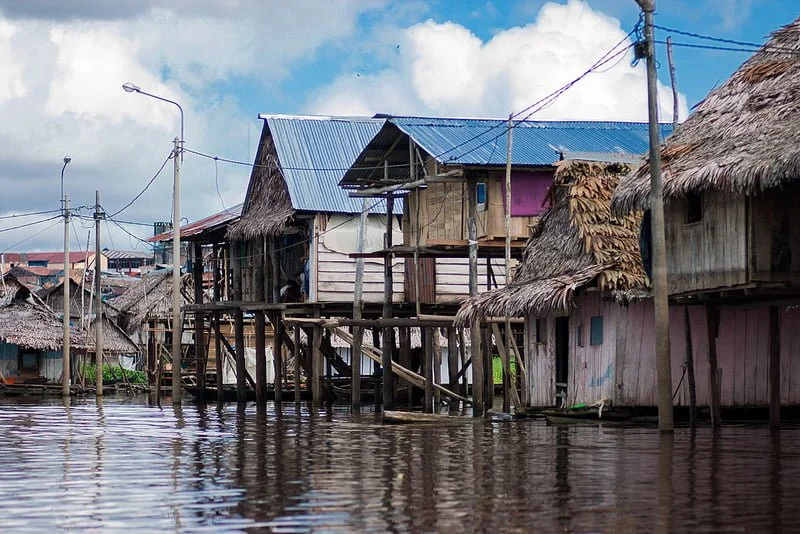
Walk the water stilt village of Belen
One of the main things to do in Iquitos is to visit Belen. Belen is a village made up of stilt houses and floating houses at the edge of the Itaya River. It’s a place that you can either visit on foot across a series of bridges and wooden planks, or a place that you can enjoy from the water by hiring a peke peke boat for a few soles.
After visiting the village, you can also take a walk through the Belen Market which mainly focuses on produce. You’ll get some fresh scents of cilantro, ginger, and ripe mangoes as you walk through a series of tarp-covered stands.
I’d recommend wearing closed shoes as it gets quite muddy the further you get into the market.

Enjoy a stroll along the waterfront
One of my favourite things to do in Iquitos is to stroll along the waterfront which offers a scenic walk – especially if you’re there around sunrise or sunset.
If you’re up early you’ll be able to catch the sun rising over the river, and if you stick around in the evening you’ll be able to catch the soft pastel shades cast by the sun as it sets behind the city.
There are also lots of little cafes with balconies and riverfront terraces where you can watch the sun do its magic, including Fitzcarrald, Dawn on the Amazon, and Arandu Bar. These all sit along a short stretch of boardwalk called Malecon Maldonado.

Explore the historic Old Town
Iquitos is a city where the modern world and the colonial past collide in a gritty and slightly chaotic mess.
The streets are abuzz with tuk-tuks, there are rows of buildings with elegant arches in a state of perpetual decay, and every once in a while you’ll come across a stately structure from centuries past covered in a colourful array of painted tiles.
One of the best things to do in Iquitos if you’re on a bit of a budget is to go on your very own self-guided walking tour.
Some places to check out include the Iron House, which is said to have been designed by the one and only Gustav Eiffel (though there isn’t much evidence of that!); the (Former) Hotel Palace, which is covered in azulejos and was once one of the most luxurious hotels in all of Peru; and Iglesia Matriz, which is the main cathedral in Iquitos.
Plaza de Armas is also worth checking out. It’s a tranquil place to enjoy some shade under a palm by day, but then it transforms into quite the lively hangout spot in the evening when vendors gather to sell balloons, flashing toys, and bubbles to a crowd of overly excited children.

Visit the Manatee Rescue Centre
If you’re looking for some underrated or lesser-known things to do in Iquitos, you can visit the Manatee Rescue Centre just outside of town.
The Amazonian manatee is a freshwater species of manatee which lives in the Amazon basin. Unfortunately, they are often hunted for their meat and also end up hurt by boat traffic.
The Amazonian Manatee Rescue Centre cares for and rehabilitates orphaned or injured manatees. Then, once they are ready, the animals are released back into the wild – usually inside the Pacaya Samiria National Reserve.
On the day we visited, there were two groups of young school children there as part of a field trip, so it was nice to see that the centre is teaching the younger generation to respect and protect the wildlife found in the region.
The centre is located a short drive from Iquitos, so you can easily hire a taxi or a tuk-tuk to take you there.

Where to stay in Iquitos
While in Iquitos I stayed at the Epoca Hotel, which is a beautiful heritage property right on the shores of the Amazon.
The hotel has a colonial hacienda feel with tall ceilings, iron balconies, and a beautiful tiled exterior.
The floors are Instagram-worthy (anyone else following #IHaveThisThingWithFloors), the walls are covered in historical photographs that depict scenes of men in white suits enjoying drinks and cigars, and you’ll also find antique furniture which really adds to the feel of the place.
We really enjoyed our stay and also found it budget-friendly, so it’s a place we’d recommend.
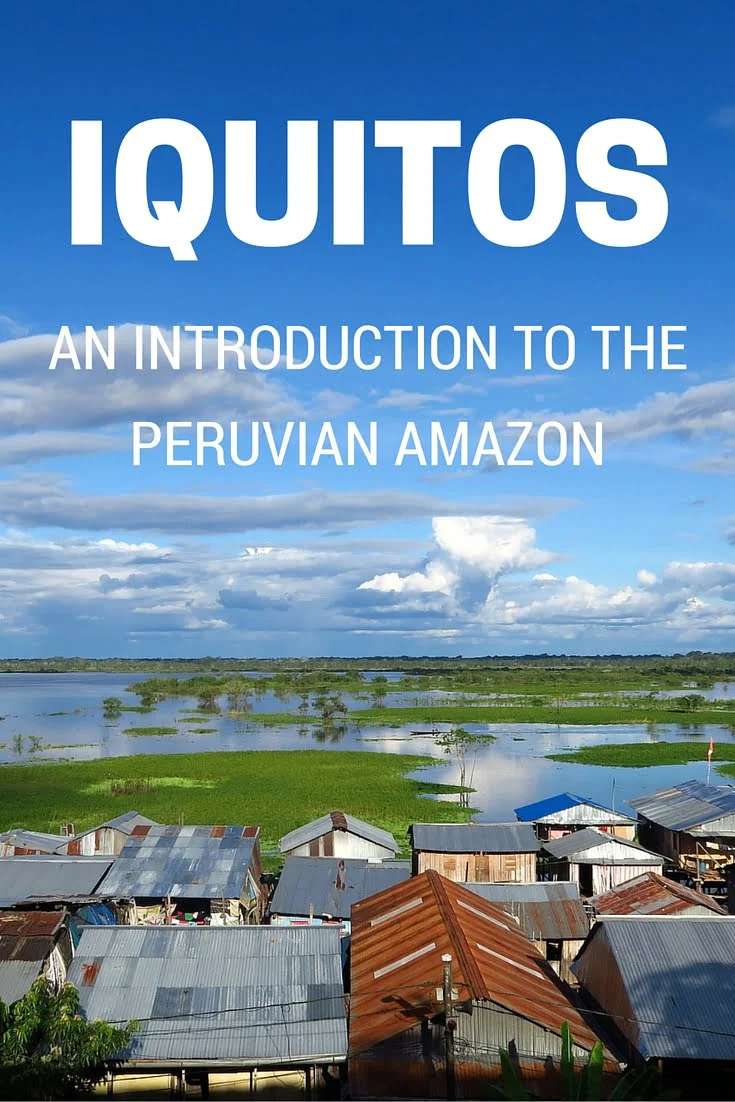
Practical Iquitos Guide: Plan, Eat, Pack & Do (Before/After Your Amazon Cruise)
You’ve got your jungle treehouse booked and your river cruise tickets in hand. Now let’s give Iquitos a couple of days to shine. Below is a super practical add-on section.
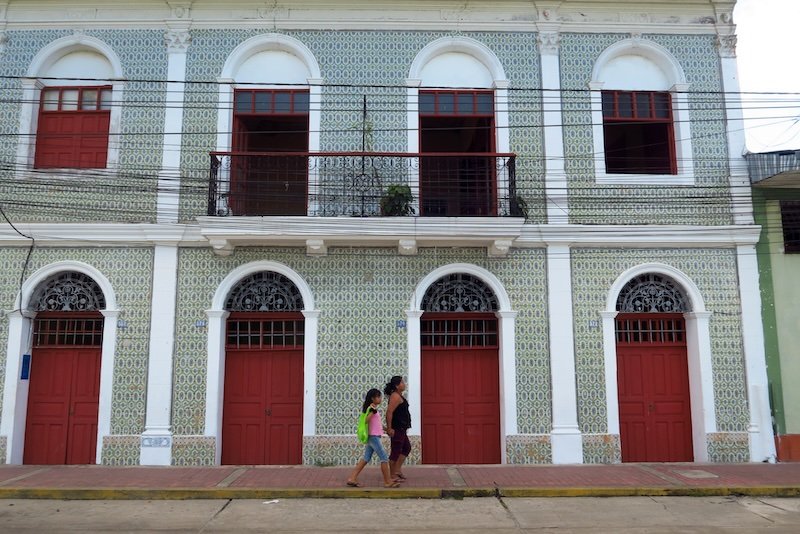
3-Day Iquitos Mini Itinerary
| Day / Base | Morning | Midday | Afternoon | Evening |
|---|---|---|---|---|
| Day 1 – Iquitos Town | Old Town walk: Plaza de Armas → Iglesia Matriz → tiled façades (peek at the Former Hotel Palace) → Iron House. | Amazonian lunch near the plaza (try tacacho con cecina or patarashca de paiche). | Malecón Maldonado stroll—cafés with balconies for river views; pop into small handicraft shops. | Sunset on the malecón (Fitzcarrald or Arandú Bar terraces) → easy dinner (juanes, grilled fish) → early night if you’re catching a dawn flight/boat. |
| Day 2 – Belén & River Life | Belén on foot with a local guide: elevated walkways, daily life on stilts. | Belén Market tasting tour (fruit juices, jungle herbs)—closed shoes a must. | Boat time: hire a peke-peke to see the floating quarter from the water or head to Pilpintuwasi Butterfly Farm & Animal Orphanage (ethical rescue). | Floating dinner at Al Frío y Al Fuego (book ahead; go by boat) or casual bites on the malecón; finish with ice cream on Plaza de Armas. |
| Day 3 – Wildlife & Culture | Manatee Rescue Centre (rehab + education). Combine with Quistococha (lakeside park) or Allpahuayo-Mishana National Reserve (rare white-sand forest) if you love nature walks. | Lunch: jungle sampler (paiche ceviche, inchicapi peanut soup). | Museum hour (if open): Amazonian Indigenous Cultures Museum or a rubber-boom house museum; souvenir hunt for chambira-fibre baskets & seed jewelry. | Golden hour boat drift on the Itaya/Nanay (ask for a short wildlife-focused ride) → back to town for live music or a nightcap. |
Swap days to fit flight/boat times; slot your cruise check-in/briefing where needed.
When to Go: River Seasons Cheat Sheet
| Season | Months | What It’s Like | Why Go | What to Pack Extra |
|---|---|---|---|---|
| High Water | Dec–May | Rivers rise 6–10 m; flooded forests; frequent showers; cooler nights. | Skiffs can glide deep into varzea (flooded jungle); wildlife at eye level; mirror-like water photos. | Light rain jacket/poncho, dry bags, quick-dry trousers, spare socks; anti-slip sandals. |
| Low Water | Jun–Nov | Sandbars and beaches appear; hotter; some channels too shallow. | Better trail access, fishing, and picnics on river “beaches”; starry skies. | Breathable long sleeves, electrolytes, sun hat with neck coverage, reef-safe sunscreen. |
Eat & Drink Shortlist (Walkable or Quick Tuk-Tuk)
- Dawn on the Amazon – breakfast on the river; fresh juices (camu-camu!), paiche plates, and leafy salads.
- Fitzcarrald – breezy balcony seating for sunset sips; reliable Amazonian classics.
- Al Frío y Al Fuego – floating restaurant reached by boat; great for a celebratory meal.
- Huasai – homestyle Peruvian-Amazon dishes (look for inchicapi soup and juanes).
- Karma Café / Amazon Bistro – traveler favorites for easy pastas, sandwiches, good coffee.
- Markets – for fruit: copoazú, aguaje, guava, soursop smoothies. If you’re cautious with raw market foods, opt for cooked items.
Cash is king for markets and small eateries; carry small soles (S/.5–20 bills).
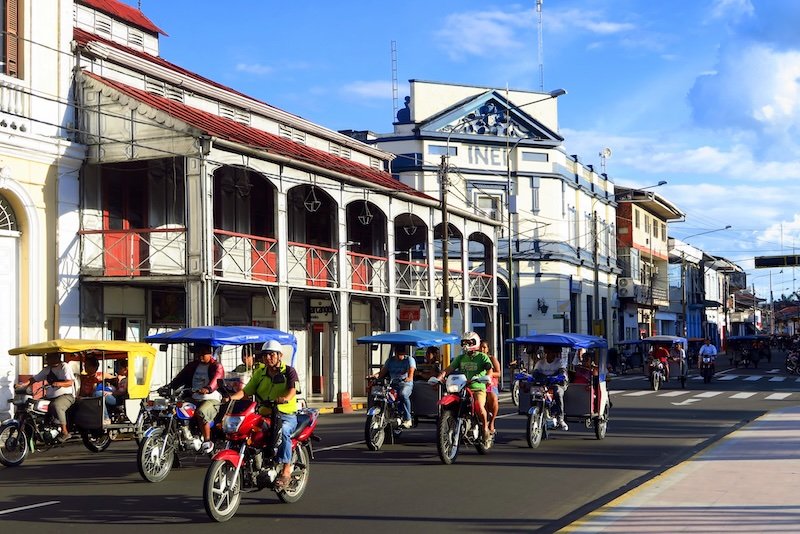
Getting In & Around (Zero Road Access, Maximum Adventure)
- Arrivals: Fly from Lima (multiple daily) or connect from Tarapoto/Pucallpa. The airport is 15–20 minutes from town; tuk-tuks and taxis queue outside.
- To town: Agree on fare before you hop in. Rough guide: tuk-tuk S/.6–10 to central hotels; taxi S/.15–25 depending on distance.
- Boats: For day rides, negotiate at the malecón or ask your hotel to prearrange. For onward river boats (to Leticia or Pucallpa), factor in multi-day hammock boats and check schedules locally.
- Cruise check-ins: Many operators transfer you from hotel → Nauta (1.5 hrs) → embarkation. Build buffer time around flights; Amazon weather can play games.
What It Costs (Approximate, per person)
- Tuk-tuk rides in town: S/.6–10 (short), S/.12–15 (cross-town).
- Belén + boat loop with guide: S/.40–80 depending on duration/negotiation.
- Manatee Rescue Centre: modest entrance fee; tuk-tuk there and back ~S/.30–40.
- Butterfly Farm/Pilpintuwasi: small entrance + boat transfer; plan half a day.
- Meals: cafés S/.20–35; sit-down dinner S/.40–70; floating fine-dining higher.
- Sunset peke-peke (1–1.5 hr): S/.60–120 per boat (share with new friends).
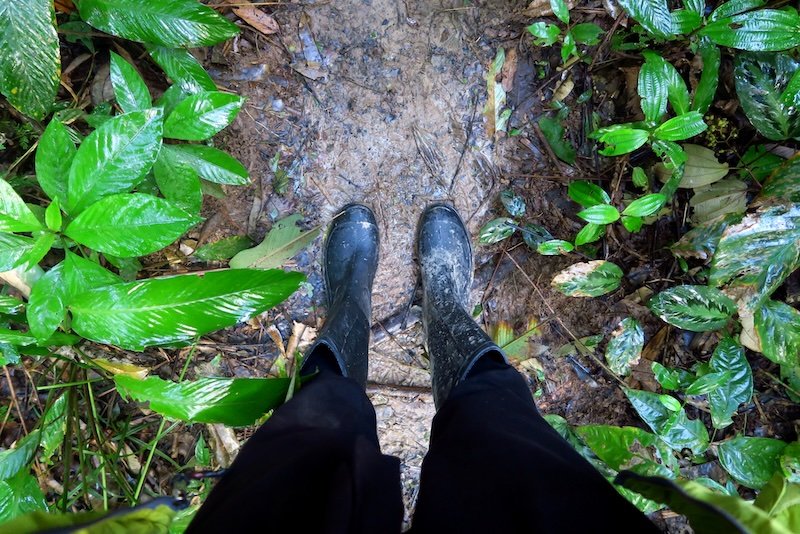
Pack for Iquitos & The River (Carry-On Friendly, Jungle Ready)
Must-Haves
- Breathable long sleeves/long trousers (mosquito armor that still breathes)
- Light rain layer + compact umbrella (showers roll in fast)
- Closed-toe walking shoes + grippy sandals for boats and wet docks
- Dry bags (phone/camera/passport) + zip bags for cords & meds
- Insect repellent with picaridin or DEET; consider permethrin-treated clothing
- Sun gear: wide-brim hat, sunglasses, reef-safe sunscreen, lip balm SPF
- Health kit: electrolytes, motion tablets (boats), basic meds, hand sanitizer
- Headlamp (power cuts happen) + power bank
- Cash (small soles) + passport copies
Nice-to-Have
- Neck fan or small cooling towel (afternoons get steamy)
- Light scarf/sarong (sun, wind, temple cover, makeshift towel)
- Packing cubes (everything stays drier/organized)
- Reusable bottle (most hotels offer filtered refills)
Power: Peru is 220V, plugs Type A/C; many devices are dual-voltage—check your charger bricks.
Health note: Yellow fever, typhoid, hepatitis A, and malaria prophylaxis may be recommended—chat with a travel clinic several weeks before your trip.
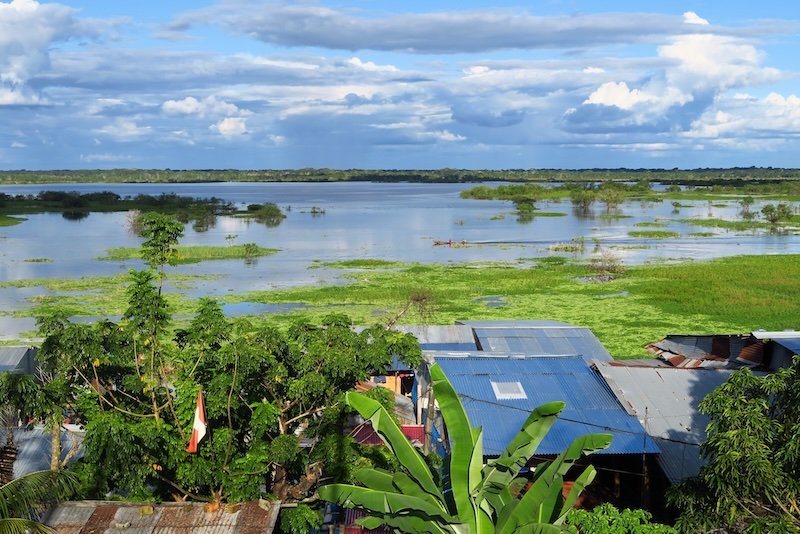
Iquitos FAQ: Quick Answers Before/After Your Amazon Cruise
1) How many days should I spend in Iquitos?
If you’re pairing Iquitos with an Amazon cruise or lodge, 2–3 full days is ideal: one day for Old Town + malecón, one for Belén (on foot and by peke-peke boat), and one for wildlife/education (Manatee Rescue Centre, Pilpintuwasi) or a nearby reserve. Add buffer time around flights—Amazon weather can delay departures.
2) What’s the best time of year to visit?
There are two “river seasons.” High water (Dec–May) means flooded forest, deeper skiff access, slightly cooler temps, and more rain showers. Low water (Jun–Nov) brings sandbars, better hiking access, hotter afternoons, and some shallow channels. Photographers love high water for reflections; hikers and fishers often prefer low water.

3) How do I get to Iquitos if there are no roads?
Fly. There are multiple daily flights from Lima (and occasional connections from Tarapoto/Pucallpa). From the airport, it’s 15–20 minutes to town by tuk-tuk or taxi. You can also arrive/leave by multi-day riverboat (hammock boats) to other Amazon cities, but plan extra time and flexibility.
4) Is Iquitos safe?
Use standard city smarts: explore central areas by day, keep valuables zipped, and tuk-tuk back to your hotel after dark. Visit Belén with a local guide, preferably in the morning. Don’t flash cash or phones in crowded markets, and always agree on tuk-tuk fares before rides.
5) What should I pack for a short stay?
Light, breathable long sleeves and trousers, closed-toe shoes plus grippy sandals, a compact rain jacket/poncho, dry bags (phone/camera/passport), insect repellent (picaridin or DEET), reef-safe sunscreen, a hat, headlamp, power bank, and small-denomination soles. If you’re continuing to the river, add electrolytes and quick-dry layers.
6) Do I need vaccines or malaria tablets?
Many travelers get yellow fever, typhoid, and hepatitis A for the Amazon region; malaria prophylaxis may be recommended depending on your itinerary and season. Consult a travel clinic 4–6 weeks before departure. Regardless, use repellent, cover up at dawn/dusk, and sleep with proper nets at jungle lodges.

7) Can I drink the water?
No. Stick to bottled or filtered water (most hotels/cafés provide refills). Avoid ice at street stalls unless you’re sure it’s purified. Wash fruit or choose peelable varieties (banana, citrus).
8) How do I see Belén and is it worth it?
Yes—Belén gives a fascinating window into stilt-house life. Go with a licensed local guide, wear closed shoes, visit in the morning, and be respectful (ask before photographing people). Pair a walking circuit with a short peke-peke boat ride to view the floating quarter from the water.
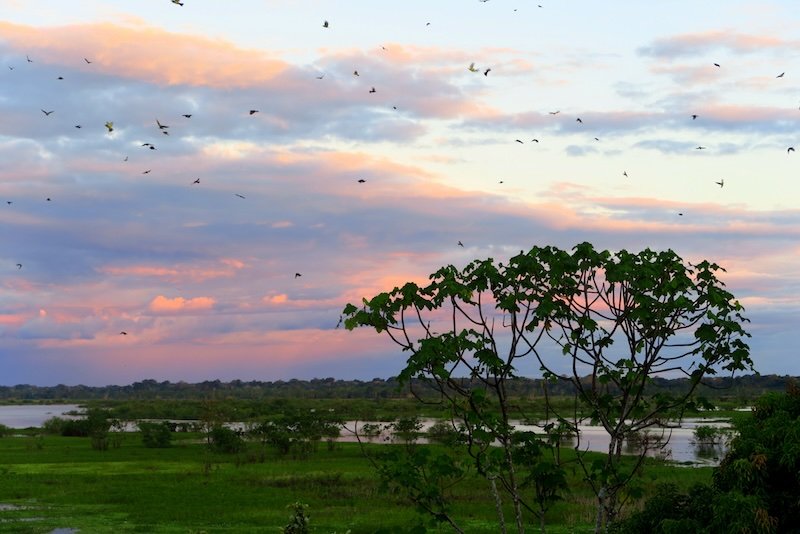
9) What are ethical wildlife options near Iquitos?
Choose registered rehab centers with veterinary care and release programs: the Manatee Rescue Centre and Pilpintuwasi Butterfly Farm & Animal Orphanage are solid picks. Avoid tours offering animal handling or “selfies” with sloths/macaws; they stress wildlife and often fuel trafficking.
10) What and where should I eat?
Try tacacho con cecina (plantain + cured pork), patarashca de paiche (steamed fish in leaf), juane (rice/chicken parcel), inchicapi (peanut soup), and juices like camu-camu or copoazú. Good, easy spots: Dawn on the Amazon, Fitzcarrald, Huasai, Amazon Bistro, and the floating Al Frío y Al Fuego (reserve and factor the boat transfer).
11) How much do things cost?
Tuk-tuks within town: S/.6–10 short hops, S/.12–15 cross-town. Guided Belén + boat: S/.40–80 (duration dependent). Manatee Rescue Centre: small entry fee; tuk-tuk round-trip ~S/.30–40. Café meals: S/.20–35; sit-down dinners: S/.40–70; sunset boat drift (1–1.5 hr): S/.60–120 per boat. Carry small bills.
12) Will I have phone service and what plugs do I need?
Buy a Claro or Movistar SIM in town (bring your passport). Wi-Fi is decent at cafés; hotel connections can wobble during storms. Peru uses 220V power; plugs Type A/C. Most modern chargers are dual-voltage—check your brick. Bring a simple adapter and a small extension if you have multiple devices.
Have you been to Iquitos?
Are there any other things to do in Iquitos you’d recommend?

Is great to know you visited Iquitos! Is an amazing place. I hope you had the opportunity to visit the deep jungle and stay a couple of nights on some lodge or camp. I have some recommendations here https://youtu.be/aEKWBdDukPY
The city is not so big but the history behind its foundation could be very interesting. I also want to reccommend you to watch the movie “Fitzcarraldo”. Is on youtube and it’s about Iquitos, I’m sure you’ll love it.
Keep traveling !
I have a question about Belen. I’m trying to do some research. I’ve read that houses are built on stilts and built on water. But I also see other pictures of houses built on stilts that are on actual land. Are there more than one residential area of Belen? It’s confusing because I see houses floating and some with wooden planks as walkways and some on land. Can you walk around Belen or only use a canoe? Also, can you walk to the market from the village on foot? Thanks for the answers.
Hi Jessica, you can definitely walk around Belen and you do not need a canoe to get around. The village is built on the river’s edge and it extends out over the water on stilts, so you have some streets on solid ground and other streets that are almost like wooden piers.